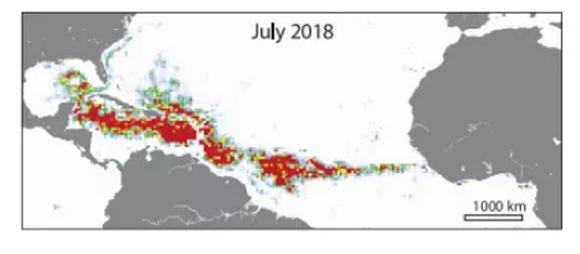 Floating mats of Sargassum seaweed in the center of the North Atlantic were first reported by Christopher Columbus in the 15th century. These mats, although abundant, have, until recently, been limited and scattered. In recent years that has changed dramatically. A new study by Mengqiu Wang and her colleagues from the University of South Florida, published in the journal Science, documents the formation of a massive mat of Sargassum seaweed stretching from West Africa to the Gulf of Mexico.
Floating mats of Sargassum seaweed in the center of the North Atlantic were first reported by Christopher Columbus in the 15th century. These mats, although abundant, have, until recently, been limited and scattered. In recent years that has changed dramatically. A new study by Mengqiu Wang and her colleagues from the University of South Florida, published in the journal Science, documents the formation of a massive mat of Sargassum seaweed stretching from West Africa to the Gulf of Mexico.
Last summer, the floating mat formed an 8850-kilometer-long belt of the brown buoyant seaweed, estimated to weight more than 20 million tons. The growth of what the authors of the study refer to as the Great Atlantic Sargassum Belt has been recorded by satellite imagery showing a dramatic increase in the size of the floating seaweed mats over the past 20 years. The researchers say that this Sargassum belt represents the world’s largest macroalgal bloom and that such recurrent blooms may become the new normal.
The Sargassum bloom is having a devastating impact on beaches across the east coast of Mexico, the Caribbean, Texas, and Florida. Tons of stinking, rotting Sargassum is washing ashore, posing a threat to both coastal sea life and to tourists. Barbadoes has declared a national emergency, while in Cancun, Mexico, “sea fences” are being built to attempt to keep the seaweed some distance offshore. Also, a Sargassum processing plant is being built to dispose of the tons of decaying seaweed.
What has caused the massive bloom? Climate change and fertilizers may play a big role. Live Science reports that Researchers identified a tipping point around 2009 when discharge from the Amazon River brought unusually high levels of nutrients into the Atlantic Ocean. Upwelling of nutrient-rich water off the west coast of Africa in the winter of 2010 further enriched surface waters with deep-sea nutrients; that upwelling also lowered temperatures of that surface water, allowing sargassum to thrive in the summer of 2011.
A similar combination of factors led to especially large blooms in 2014, 2015 and 2017. The largest recorded bloom occurred in 2018, when the Great Atlantic Sargassum Belt grew to a mass of more than 20 million metric tons. The high levels of nutrients from the Amazon River come from deforestation and fertilizer use in the Amazon basin.
Onslaught Of Seaweed Affecting US Beaches, Could Pose Health Risks

Use it as fertiliser on farmland… what goes around comes around.
As the sand piles onto it, it will make the land more stable toward storm damage.
What would have been more dramatic is if man could walk on that mass of seaweed.